7 Best Help Desk Software for a Small Business
Trying to find the best help desk software for your small business? We've compiled 7 best-in-class solutions that will definitely suit your needs. Check them out!
Written by Anastasiia Khlystova
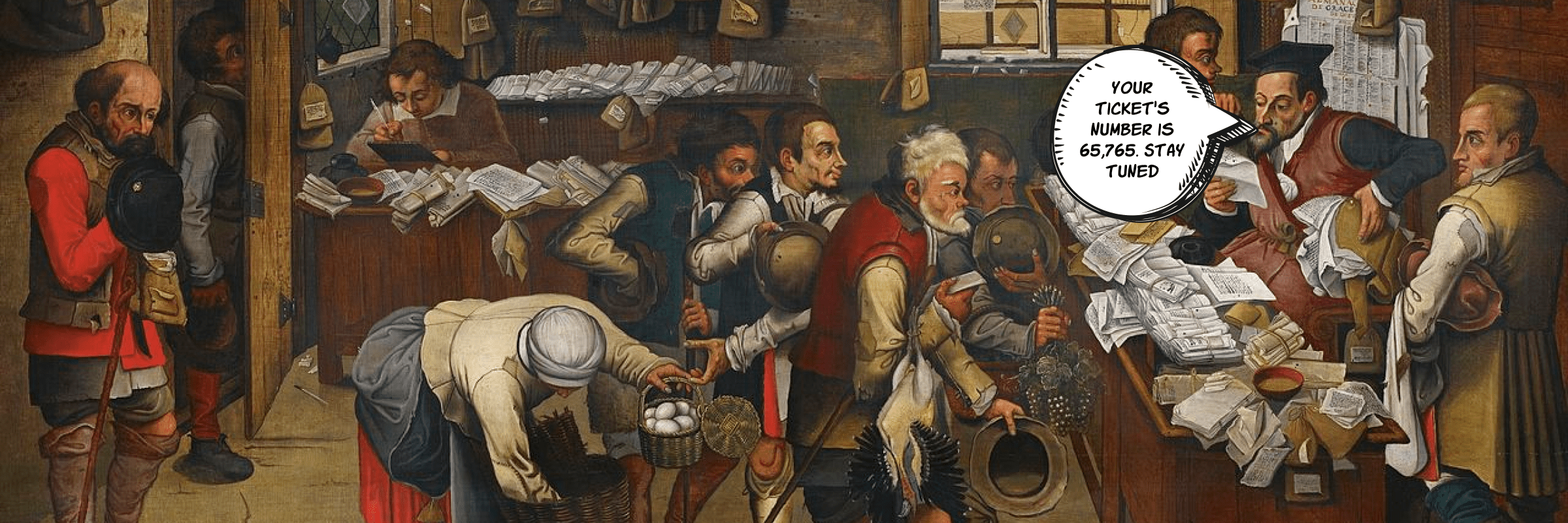
Would I startle you if I mention that people are willing to spend 17% more on companies with great customer service?
No, I don’t think I would.
You probably already know that customer service is almost as important as your product. The only question left is how to achieve that excellence.
If you’re a rising star in your niche, the right help desk software for a small business will be the foundation of further customer service success. Picking a platform that doesn’t fit your goals or budget will translate into real issues for your team soon enough.
But what does ‘right’ mean? Well, let’s find out.
What is help desk software?
A help desk is used to manage customers’ problems when they arise, allowing for them to be logged, tracked, and (hopefully) finally resolved. It focuses on facilitating communication between support staff and end-users to help solve issues, and its purpose is to keep things running on a day-to-day basis.
Such software lets you manage client requests as effectively as possible. Ideally, it’s a place where your team stores everything from tickets, tasks, and logs to reports and more.

Here’s what you should look for in a help desk platform:
- Omni-channel support (email, live chat, social media, phone calls)
- Team collaboration features like private notes, collision detection, etc.
- The ability to assign, merge, and escalate incoming requests
- Productivity features like tags, statuses, or saved responses
- Automation features like reminders, ticket routing, etc
- Real-time customer profiles
- Detailed customer service reports
Basically, when you choose ticketing software for a small business, it becomes your single source of truth. You can see why picking a platform would be an important decision — migrate your team to a wrong solution, and you’ll lose weeks, if not months, in productivity in the long term.
7 help desk software for a small business to ramp up support
There is a myriad of options out there. So opting for THE one might be a daunting task at first. With that in mind, we listed up 7 by far the best of them so you can choose whatever suits your needs.
1) HelpCrunch — one-stop help desk software for live chat and email support
HelpCrunch is a great example of a one-stop small business help desk software. Each of its features plays an equally important role in the overall experience bringing your entire customer service efforts under one dashboard.
Customers will enjoy the ability to communicate with your reps via live chat, chatbot, or emails, and troubleshoot on their own by taking advantage of knowledge base software. But the real magic is happening inside.
Your HelpCrunch dashboard is the destination point of all the chats and emails that customers are sending. Incoming requests will be displayed on the dashboard as separate conversations (aka tickets) where they pile up in chronological order.
There are a lot of ways to arrange and interact with those tickets in a way that makes the most sense for your team’s workflow. As your customer service reps start solving issues, they can:
- Assign a ticket to themselves or to any of their teammates;
- Set up your E-commerce or SaaS help center and reply to customers with a knowledge base article right from the chat or with a saved response;
- Set up the chatbot to automate the customer support routine, like taking over repetitive questions, collecting contact details, or qualifying leads;
- Forward individual chat messages via email manually or automatically after a certain period of time;
- Leave private notes to their teammates, which will appear in the chat thread but won’t be visible to customers;
- Create canned responses and use them any time a client asks a relevant question;
- Assign custom tags based on a ticket’s content (e.g ‘feature request’, ‘bug’, ‘PPC campaign’, ‘Christmas sale’);
- Keep track of tasks by changing a ticket’s status from new to open, pending, on hold, or closed.
HelpCrunch displays users’ data next to the chat window at all times, so your service reps always have the information they need to provide top-notch support. By default, the platform will include user path, recent activity, full chat history, and browser information, but you can pass your custom data about customers, too.
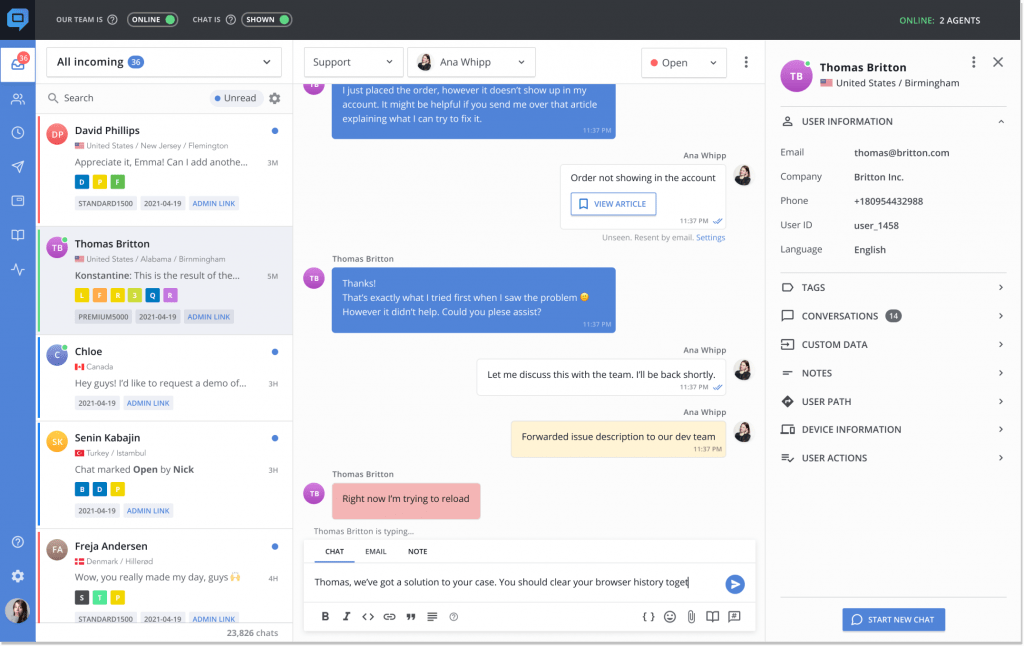
To prioritize incoming tickets, your team is able to filter them by their status — new, open, pending, on-hold, or closed. Individual members can also access tickets assigned to them with a single click.
Once the ticket is resolved, the customer will be asked to rate their experience. This provides a simple way for you to monitor customer satisfaction levels, as well as track the performance of individual service reps.
You can also gauge key performance metrics — ticket resolution time, first response rate, busy hours, and the overall number of resolved tickets. Each report can be broken down by a particular period, giving you a bird-eye view of all your customer service activities.
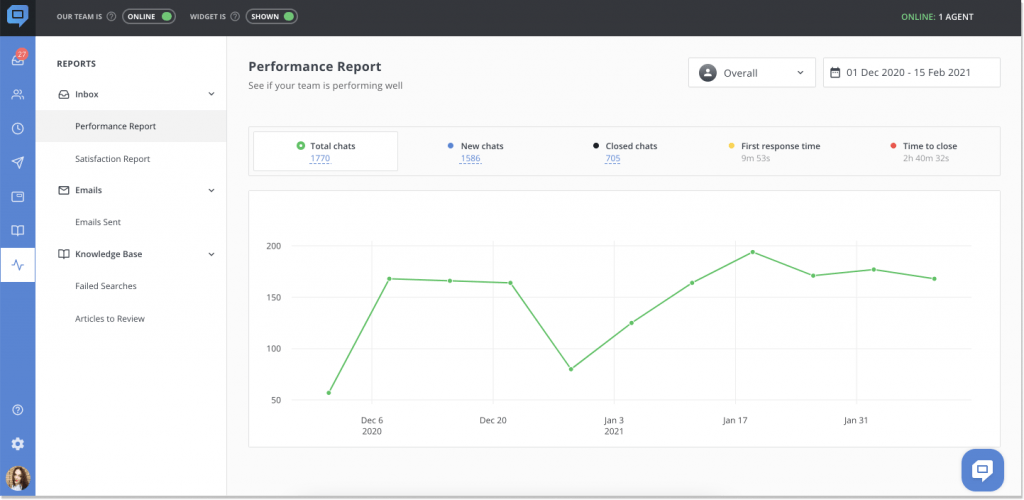
Price
The ‘Basic’ subscription plan costs $15/mo per team member if billed monthly. It includes a knowledge base, in-app pop-ups, and all help desk features mentioned above (except email functionality).
If email is an important channel for your work, it’s probably better to go buy this additional tool. The price will depend on the number of emails you are going to send. For instance, 10,000 emails will cost $24/mo on top, which is a good deal I must say.
With the ‘Pro’ plan, you can get 5 chat widgets, a chatbot tool, unlimited auto messages and unlimited popups. This plan will set you back $25/mo per team member if billed monthly.
Verdict
HelpCrunch is the perfect choice if you’re looking for something simple and affordable. Its help desk platform will streamline your team’s customer service workflow, and it doesn’t clutter your dashboard with redundant features (hello, legacy software).
Power users might find HelpCrunch lacking some enterprise-level help desk features like workflow automation or custom tickets’ queue. However, if you’re running a small business you should probably think twice if you ever needed those in the first place — if the answer is no, then why complicate your customer service workflow and overspend?
2) Zendesk — the ultimate help desk software
When someone says ‘help desk’, Zendesk is probably the first tool that comes to people’s minds.
That’s not a coincidence. Zendesk started off as one of the first ticketing systems for a small business way back in 2007 and they’ve been perfecting every feature ever since. Plus, they literally have the word ‘desk’ in their brand.
As of today, Zendesk is a powerhouse of customer service tools, providing live chat, email support, knowledge base, cloud call center, and whatnot in addition to the help desk platform.

It allows your team to manage customer requests in any way they see fit. Your service reps will be able to organize the queue based on ticket status, assignee, customer group, and other conditions.
Plus, there’s this quirky button at the top right corner called ‘Play’, which basically guides a support agent from one ticket to another until all of them are resolved.
Once your team member opens a ticket, they have a variety of ways to interact with it:
- Assign a ticket to a corresponding person or department;
- Use saved responses (aka ‘macros’) to resolve common issues faster;
- Leave private notes for other teammates;
- Specify the ticket’s priority and type (e.g. incident, question, task);
- Link similar tickets or related tasks;
- Add supervisors that will monitor ticket’s progress;
- Change its status from open to pending or closed.
As with HelpCrunch, user data including recent activity, path, location, and more is displayed when an agent takes over a ticket.
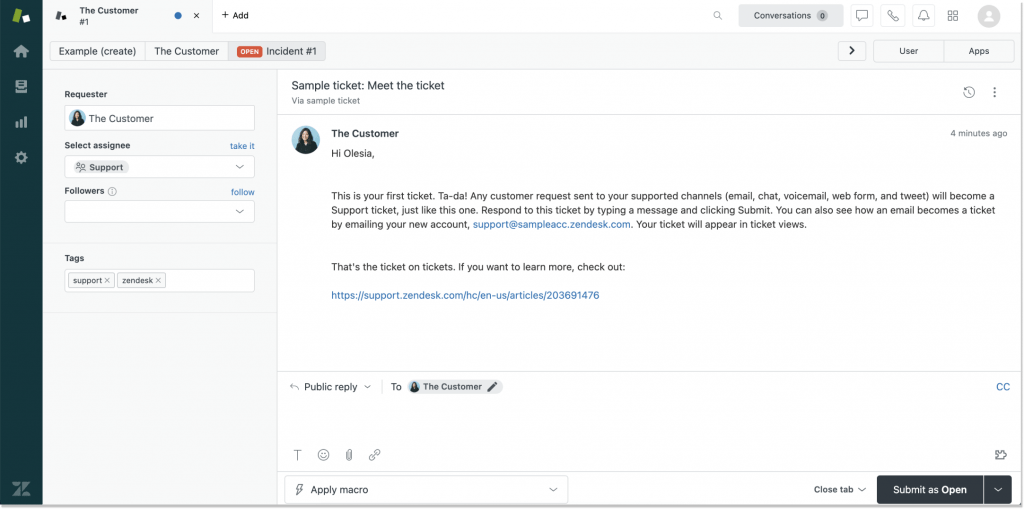
There’s even more going on in the Settings section of your account. That’s where you can set up trigger-based notifications that will inform your team about any change inside a ticket (like a new reply, a reopen, etc). These notifications will be based on certain conditions that you choose. You can also create custom roles and assign them specific permissions inside the Zendesk dashboard.
As an enterprise-level solution, Zendesk allows you to take advantage of customer service automation. For example, you can create a rule that the ticket will be closed four days after its status is set to ‘solved’. If you’re running a large team, these workflows can save a lot of time.
Zendesk also provides rich reporting and analytics tools. You can track every aspect of your customer service experience, and get a ton of insights into the performance of your team and customer satisfaction levels.
Price
The good news is that Zendesk offers free versions of all their products. All of them — except for the help desk.
If you need a help desk, you have to go with the Support subscription. The base plan will cost you $19/mo per agent if billed annually, but if you want to enjoy all those advanced automations, full reports, and 99.9% uptime SLA, the price can be as high as $99/mo if billed annually.
Verdict
Zendesk is a great platform, but I wouldn’t necessarily say it’s the best help desk software for small businesses. Ironically, it has too many features to be one.
In-depth collaboration, automated notifications, various custom views, and permissions won’t make any sense if your customer support is a one-person job. They are great for a huge company but will simply slow you down if you plan on staying lean.
3) Freshdesk — feature-packed help desk solution
Freshdesk is the help desk software for small businesses by a company called Freshworks, which also offers live chat (Freshchat), call center (Freshcaller), conversion optimization (Freshmarketer, you see the pattern), and much more. As such, it’s a bit less of a complete package by design — if you want to run your business on Freshworks, you’ll have to construct your stack like a LEGO set.
But their help desk platform is fully featured and is generally considered to be one of the top Zendesk competitors. Sure, there are other tools that were building their solutions for years, but pretty much all of them feel dated.
For both Zendesk and Freshdesk, that’s not the case.
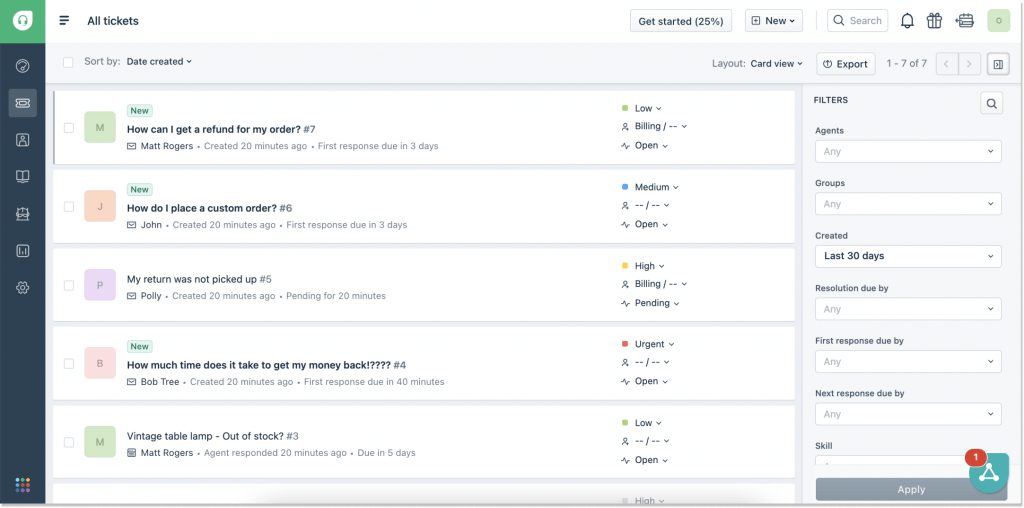
Just like with HelpCrunch or Zendesk, your team is able to interact with tickets to keep track of their progress. You can:
- Assign tickets to a specific agent and group
- Send canned responses
- Filter tickets based on specific properties
- Merge similar tickets
- Set up custom views to organize tickets’ queue

There are also some powerful collaboration features like collision detection or activity log. Freshdesk also offers an internal chat for coworkers where they can discuss issues and collaborate when working on a ticket.
As with Zendesk, Freshdesk is pretty big on automation, allowing you to perform certain routine actions on autopilot. For instance, the system can automatically assign tickets to corresponding departments or set the priority based on certain keywords they contain. Reporting and metrics features are also included in the package.
Price
One of the best things about Freshdesk is that they offer a free version of their software. You can get a pretty decent ticketing system for $0 — if you don’t want to take advantage of reporting and automation systems.
The basic Blossom subscription with time- and event-based automations, reporting, and SLA management will set you back $15/mo per agent. More advanced plans will cost you somewhere between $35 and $99 per agent per month.
Note that other Freshworks’ products are also available in free versions, so that’s something to think about.
Verdict
Since Freshdesk has five different subscription options, it can become a great help desk for any business. Want simple email ticketing? Go with the free account.
Need a powerful machine for a big team with custom roles, full portal customization, and rich reports? You’re covered (for a price).
Picking the right subscription can be a hassle, but Freshdesk is worth the trouble if you’re running a mid-sized business and don’t want to spend money on Zendesk.
4) LiveAgent — help desk software for email, live chat, phone, and social media support
LiveAgent is a very diverse customer service tool that covers almost every channel including live chat, calls, knowledge base, social media, and more.
As a result, LiveAgent’s dashboard can feel a bit cluttered at first sight. For instance, you have to switch between separate tabs to handle emails, chats, and phone calls, which can be challenging at times.
LiveAgent tries to simplify in other areas, like ticket statuses. When you start working with this platform, incoming tickets will fall into one of two buckets (‘All’ or ‘Assigned to me’). If you wish to better organize your shared inbox, you’ll have to do it yourself.
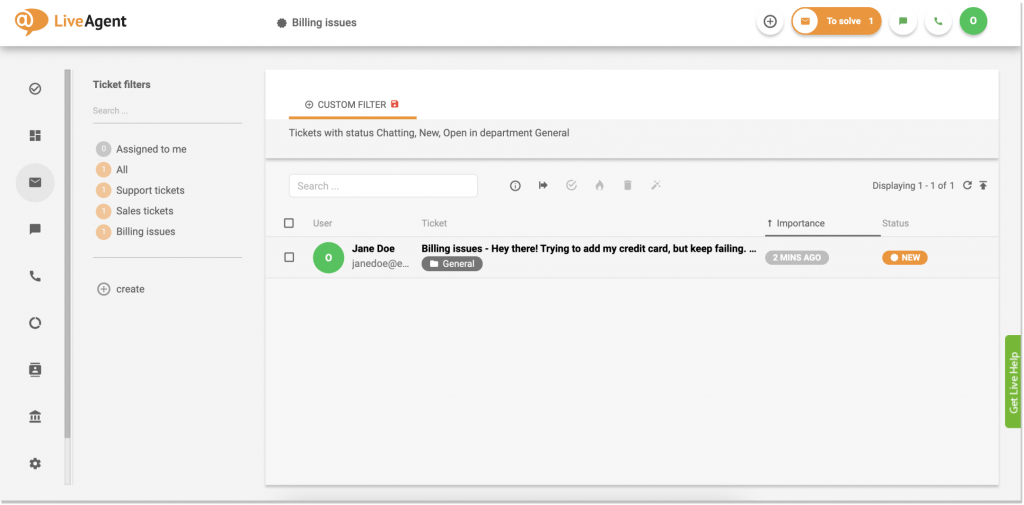
With individual tickets, customer service agents are able to:
- Add custom tags;
- View and edit user data if necessary;
- View the full ticket history with previous conversations;
- Send saved responses or predefined answers.
If you’re accustomed to running your customer support conversations in a live chat, LiveAgent can be a bit of a shock. The ticket window looks less like WhatsApp and more like Gmail. Who knew email can be such a design inspiration in 2021:

LiveAgent also helps you automate parts of your workflow based on time- and action-based rules. For example, you can automatically close or tag tickets if they’re not solved for a week. There are even specific rules that automatically assign SLA levels to your tickets.
As a bit of simple fun, LiveAgent includes a ‘gamification’ feature that allows your team members to gain badges and level-up based on their performance. Will it increase your productivity? Who knows — but it’s certainly a great way to make the hours go by.
Price
LiveAgent conveniently offers just three subscription plans — Ticket, Ticket + Chat, and All-inclusive, so you won’t spend hours comparing different plans (hi Freshdesk).
The basic Ticket subscription plan costs $15/mo per agent if billed monthly and includes email ticketing, knowledge base, and contact forms. What’s pretty awesome, LiveAgent doesn’t lock workflow automations under a more expensive plan, so you’ll be able to take full advantage of them even if you don’t upgrade.
However, you will need to upgrade if you need a live chat ($29/mo if billed monthly) or call center features. The latter plan called All-inclusive will set you back $39/mo per agent if billed monthly, and you’ll have access to the full platform’s functionality including things like advanced reports.
Verdict
LiveAgent is probably the best option for people who are used to email customer support. As a dedicated solution, it’s not as engrossing as Zendesk or Freshdesk, and it doesn’t look as modern as HelpCrunch — but if you’re living in your email inbox, LiveAgent’s dashboard will look like home.
What’s more important, their pricing policy is SMB-friendly. Even the most basic subscription plans include live chat and automations, which is rather rare for help desk software.
5) Kayako — fully-featured but simple help desk software
Kayako is one of the oldest small business help desk software out there. It was founded way, way back in 2001 and stays popular up to date.
(Just imagine, many businesses evaluating Kayako for their team employ people who were not even alive when it launched.)
Considering this, it’s a pretty great achievement that Kayako managed to keep their platform pretty straightforward and not bloat it with non-essential features and dated UI:

As a help desk tool, Kayako allows customer support reps to perform pretty much the same actions as other solutions on the list:
- Access user data including customer journey and recent activity;
- Assign types and priorities to your tickets;
- Change statuses from open to pending and completed;
- Send saved responses (aka macros) to customers;
- Leave private notes for your teammates.
Agents can also see who else is viewing their ticket in real-time, and Kayako allows you to add up to 5 collaborators for free. Collaborators are able to discuss tickets with other agents, but can’t talk to customers directly. What’s pretty cool, Kayako allows you to keep the conversation in one thread, even if the customer is switching channels (starting with live chat and switching to email, and so on).
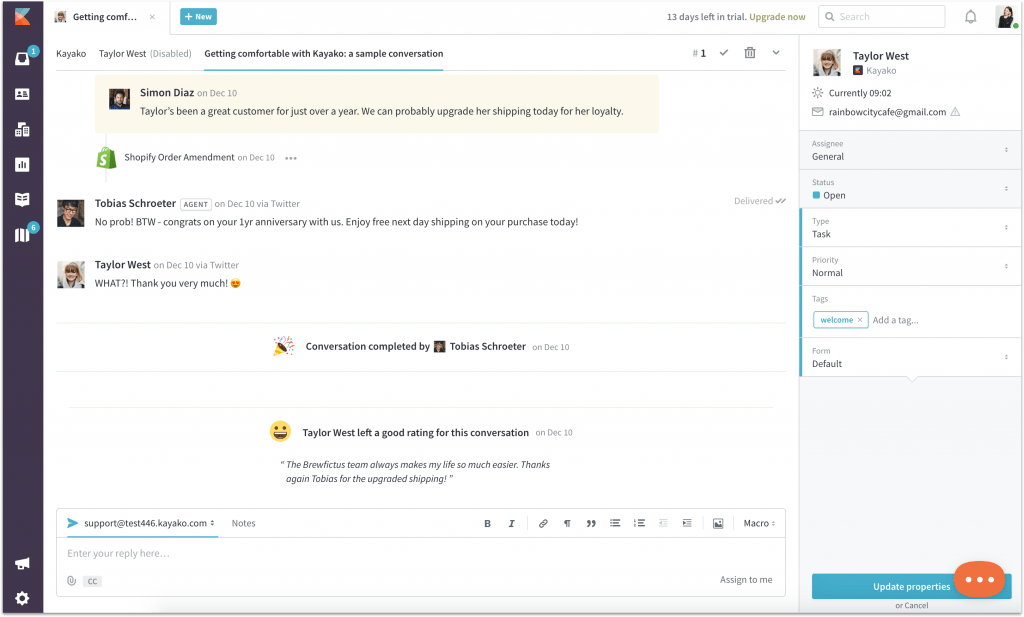
Kayako’s also pretty big on automation, offering trigger-based workflows for routine tasks, automatic reminders and notifications for agents, and more. And as with any other platform on this list, you’ll get access to SLA reporting and various customer success insights.
Price
The basic Inbox plan costs $15/mo per agent if paid annually. It includes email, live chat, and social media functionality right away, making it a good value for a small- to mid-size business.
However, event- and time-based automations, as well as custom conversation views are only available in the Growth subscription ($30/mo per agent if paid annually). And if your business depends on Salesforce, you’ll be stuck with the Scale plan that sets you back $60/mo per agent if paid annually.
Verdict
Kayako is a bit less exciting than the other tools on this list, and it doesn’t include fun features like gamification or a chat-like interface. But it’s robust and comes with an intuitive and customizable help desk interface. I mean it’s a help desk to its core.
If the pricing makes sense to you, it’s a great option.
6) Help Scout — a shared mailbox for different teams, emails, and brands
Help Scout is a perfect small business help desk system for those who want to keep customer correspondence from emails and phone under one roof. A user-friendly interface won’t let you blunder away an important message: you see its waiting time, a sender, and a conversation’s number in your mailbox (this is how they call their help desk feature).
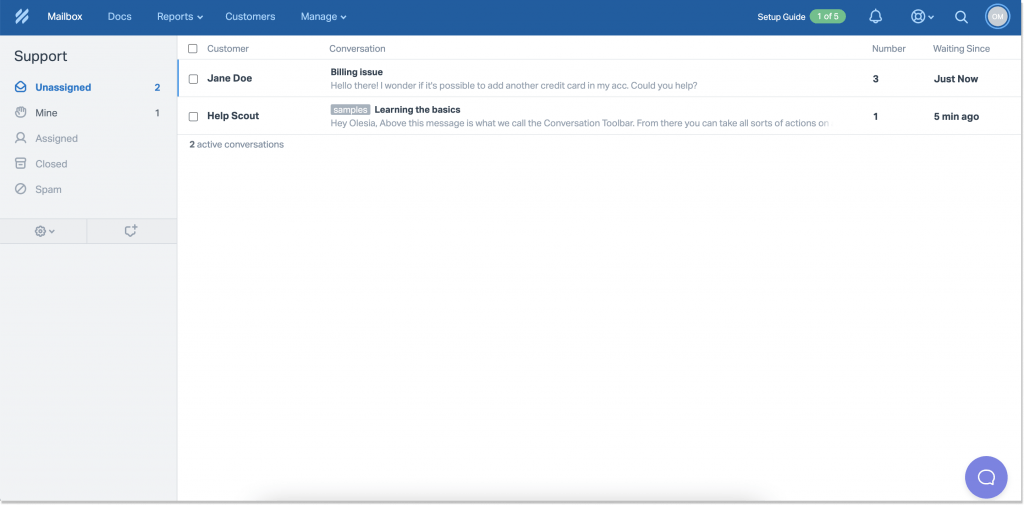
Among a basic toolset Help Scout’s mailbox provides (I mean, you see all unassigned, assigned, and closed messages), it involves other strong points, such as:
- Mailbox editing
- Creating canned responses
- Adding custom fields
- Enabling auto reply
- Creating tags
- Building customer properties
- Enabling satisfaction ratings
- Adding teammates to your inbox board
This small business help desk system has also a report feature. Thanks to it, you can monitor such key-note customer service metrics as first response time, resolution time, or response time for email support. Besides, there is a company report which tells you how many clients are helped, how many conversations you have per day, and their happiness score.

Price
There are 3 pricing tiers: Standard ($20/mo), Plus ($35/mo), and Company (custom price). The numbers are specified if billed annually.
Striking is that Help Scout provides also a certain Startup and a Basic plan ideal for small businesses who aren’t ready for a major stride yet. A 15-day free trial is available, too.
Verdict
The ticketing system for a small business should be intuitive and affordable. Help Scout proves to be just like that. Lots of pricing plan options and a solid bare minimum: what’s not to like if you’re just getting started?
7) GrooveHQ — a unified inbox for email, media, chat, and phone support
If you want unpacked onboarding information from the very start, GrooveHQ might be your go-to solution. This help desk software for small businesses gives a whole bunch of pre-loaded conversations in your inbox the moment you create it. This way, you see the whole picture and get ready for real-world communication. A really nice-to-have trick to walk a user through the basics, so take good note.

Like with any other software we discussed today, Groove lets you see all sorts of customer data ranging from a phone number, location, or timezone to company’s social media accounts, company information, and browser info.
Speaking of other components the Grove’s dashboard offers, they almost bear a certain resemblance to the ones of HelpCrunch:
- All inbox messages are gathered in one place;
- A knowledge base is accessible right from this interface;
- Report data on conversations, team’s productivity, agents, and team overview is at your fingertips;
- Layout changing (either 3- or 4-column view);
- A chat button can be reached from the dashboard and installed in just a few clicks;
- Profile settings along with Organization, Integrations, and Custom Fields can be reached in no time.
Sure thing, such niceties as chat tagging, agent assigning, or a knowledge base integration remain, and they all can be installed down the line as you explore your inbox.
Price
The given ticketing system for a small business might be the biggest bang for your buck. There are Starter, Plus, and Pro packages ($12/mo, $20/mo, and $35/mo respectively if billed annually). Groove also offers an Early Stage Startups plan for less than 10 employees.
Verdict
My verdict is loud and clear: if you’re an up-and-comer and want to dip your toe, Groove might be just the thing. Its mockup dashboard messages and all the explanations won’t go amiss at first blush.
Final words
As you can see from this list, there’s no shortage of help desk platforms. 14 years after Zendesk’s launch, there’s a whole world of powerful (and affordable) small business ticketing systems that will make your customer service team more productive and customers happier.
If you plan to grow (who doesn’t?), investing in a help desk platform is one of the best ways to make sure your business is successful a year, five years, or a decade from now.
Remember the stats from the first paragraph of this article. Excellent support directly translates into more revenue, so just sign up for a free 14-day trial with HelpCrunch and start building your all-star customer service this minute.





